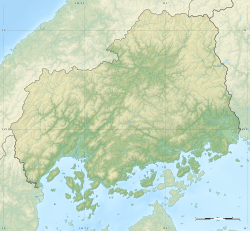Akinada Bridge
The Akinada Bridge (安芸灘大橋, Akinada Ō-hashi) is a suspension bridge in Kure, Hiroshima, Japan that crosses the Seto Inland Sea. Completed in 1999, it has a main span of 750 m.[1] It was constructed by Penta-Ocean Construction, at a cost of 50 billion yen.[2]
Akinada Bridge 安芸灘大橋 | |
|---|---|
 | |
| Coordinates | 34°12′22″N 132°40′46″E |
| Carries | Motor vehicles, pedestrians and bicycles |
| Crosses | Seto Inland Sea |
| Locale | Kure, Hiroshima, Japan |
| Maintained by | Hiroshima Prefecture Road Corporation |
| Characteristics | |
| Design | Suspension bridge |
| Total length | 1,175 m (3,855 ft) |
| Width | 12.7 m (42 ft) |
| Height | 119.45 m (392 ft) |
| Longest span | 750 m (2,461 ft) |
| Clearance below | 40 m (131 ft) at mid-span |
| History | |
| Construction end | 1999 |
| Opened | 18 January 2000 |
 Akinada Bridge Location in Hiroshima Prefecture | |
Overview
The bridge was opened to traffic on 18 January 2000. The bridge is part of Hiroshima Prefecture Route 74, a route that begins in Honshu and crosses over the Seto Inland Sea via the Akinada Bridge to Shimo-kamagari Island to the south. The bridge is tolled and operated by the Hiroshima Prefecture Road Corporation. It is the longest bridge in Japan to be maintained by a prefecture.[3]
gollark: I agree.
gollark: Unicode defines the symbols, Twitter's Twemoji is a common standard for how they look.
gollark: Which are ultimately defined by the Unicode Consortium.
gollark: Interestingly enough, they're actually Twitter's emojis.
gollark: No.
References
- "橋梁年鑑 安芸灘大橋 詳細データ" [Bridge data Akinada Bridge] (in Japanese). Retrieved 11 December 2018.
- http://www.hprc.or.jp/akinada_bridge.htm
- "安芸灘大橋(あきなだおおはし)" [Akinada Bridge] (in Japanese). 2018. Retrieved 11 December 2018.
This article is issued from Wikipedia. The text is licensed under Creative Commons - Attribution - Sharealike. Additional terms may apply for the media files.